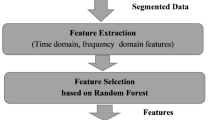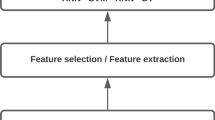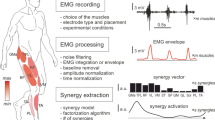Abstract
Previous pattern recognition algorithms using surface electromyography (sEMG) have been developed for subsets of predefined hand movements without considering muscle structure. In order to decode hand movements, it is important to know which movements are appropriate for PR due to the different independence of movements between individuals and the high correlated characteristics of sEMG patterns between movements. This paper proposes a method to personally rank the order of hand movements from subsets (31 finger flexion, 31 finger extension, and 4 wrist movements in this paper). The movements were sorted into a ranked order with respect to the locations of the electrodes on the proximal forearm and the distal forearm. We evaluated the classification error as the number of desired movements (N m) changed. The maximum N m with an error lower than 10% was 20 for the proximal forearm and 10 for the distal forearm from ranked movements of individuals. Our method could help to identify the optimized order of hand movements considering the personal characteristics of each individual.










Similar content being viewed by others
References
Al-Timemy AH, Escudero J, Bugmann G, Outram N (2013) Protocol for site selection and movement assessment for the myoelectric control of a multi-functional upper-limb prosthesis. Annu Int Conf IEEE Eng Med Biol Soc 2013:5817–5820
Al-Timemy AH, Bugmann G, Escudero J, Outram N (2013) Classification of finger movements for the dexterous hand prosthesis control with surface electromyography. IEEE J Biomed Health Inform 17(3):608–618
Al-Timemy A, Khushaba R, Bugmann G, Escudero J (2015) Improving the performance against force variation of EMG controlled multifunctional upper-limb prostheses for transradial amputees. IEEE Trans Neural Syst Rehabil Eng 24(6):650–651
Amsüss S, Goebel PM, Jiang N, Graimann B, Paredes L, Farina D (2014) Self-correcting pattern recognition system of surface EMG signals for upper limb prosthesis control. IEEE Trans Biomed Eng 61(4):1167–1176
Artemiadis PK, Kyriakopoulos KJ (2010) An EMG-based robot control scheme robust to time-varying EMG signal features. IEEE Trans Inf Technol Biomed 14(3):582–588
Artemiadis PK, Kyriakopoulos KJ (2011) A switching regime model for the EMG-based control of a robot arm. IEEE Trans Syst Man Cybern Part B Cybern 41(1):53–63
Bunderson NE, Kuiken TA (2012) Quantification of feature space changes with experience during electromyogram pattern recognition control. IEEE Trans Neural Syst Rehabil Eng 20(3):239–246
Cesqui B, Tropea P, Micera S, Krebs HI (2013) EMG-based pattern recognition approach in post stroke robot-aided rehabilitation: a feasibility study. J Neuroeng Rehabil 10:75
Chattopadhyay R, Jesunathadas M, Poston B, Santello M, Ye J, Panchanathan S (2012) A subject-independent method for automatically grading electromyographic features during a fatiguing contraction. IEEE Trans Biomed Eng 59(6):1749–1757
Choi E, Lee C (2003) Feature extraction based on the Bhattacharyya distance. Pattern Recognit 36(8):1703–1709
Cipriani C, Antfolk C, Controzzi M, Lundborg G, Rosen B, Carrozza MC, Sebelius F (2011) Online myoelectric control of a dexterous hand prosthesis by transradial amputees. IEEE Trans Neural Syst Rehabil Eng 19(3):260–270
De Luca CJ, Gilmore LD, Kuznetsov M, Roy SH (2010) Filtering the surface EMG signal: movement artifact and baseline noise contamination. J Biomech 43(8):1573–1579
Ertuğrul ÖF, Kaya Y, Tekin R (2015) A novel approach for SEMG signal classification with adaptive local binary patterns. Med Biol Eng Comput 54(7):1137–1146
Fougner A, Scheme E, Chan ADC, Englehart K, Stavdahl Ø (2011) Resolving the limb position effect in myoelectric pattern recognition. IEEE Trans Neural Syst Rehabil Eng 19(6):644–651
Häger-Ross C, Schieber MH (2000) Quantifying the independence of human finger movements: comparisons of digits, hands, and movement frequencies. J Neurosci 20(22):8542–8550
Han H, Jo S (2013) Supervised hierarchical Bayesian model-based electomyographic control and analysis. IEEE J Biomed Health Inform 18(4):1214–1224
He J, Zhang D, Sheng X, Li S, Zhu X (2014) Invariant surface EMG feature against varying contraction level for myoelectric control based on muscle coordination. IEEE J Biomed Health Inform 19(3):874–882
Ives JC, Wigglesworth JK (2003) Sampling rate effects on surface EMG timing and amplitude measures. Clin Biomech 18(6):543–552
Jung H, Ko C, Kim JS, Lee B, Lim D (2015) Alterations of relative muscle contribution induced by hemiplegia: straight and turning gaits. Int J Precis Eng Manuf 16(10):2219–2227
Khushaba RN, Kodagoda S, Takruri M, Dissanayake G (2012) Toward improved control of prosthetic fingers using surface electromyogram (EMG) signals. Expert Syst Appl 39(12):10731–10738
Kiguchi K, Hayashi Y (2012) An EMG-based control for an upper-limb power-assist exoskeleton robot. IEEE Trans Syst Man Cybern Part B Cybern 42(4):1064–1071
Kilbreath SL, Gandevia SC (1994) Limited independent flexion of the thumb and fingers in human subjects. J Physiol 479(Pt 3):487–497
Lee SW, Wilson KM, Lock BA, Kamper DG (2011) Subject-specific myoelectric pattern classification of functional hand movements for stroke survivors. IEEE Trans Neural Syst Rehabil Eng 19(5):558–566
Lee S, Kim H, Jeong H, Kim J (2015) Analysis of musculoskeletal system of human during lifting task with arm using electromyography. Int J Precis Eng Manuf 16(2):393–398
Matrone GC, Cipriani C, Carrozza MC, Magenes G (2012) Real-time myoelectric control of a multi-fingered hand prosthesis using principal components analysis. J Neuroeng Rehabil 9(1):40
Micera S, Carpaneto J, Raspopovic S (2010) Control of hand prostheses using peripheral information. IEEE Rev Biomed Eng 3:48–68
Momen K, Krishnan S, Chau T (2007) Real-time classification of forearm electromyographic signals corresponding to user-selected intentional movements for multifunction prosthesis control. IEEE Trans Neural Syst Rehabil Eng 15(4):535–542
Naik G, Nguyen H (2015) Non negative matrix factorization for the identification of EMG finger movements: evaluation using matrix analysis. IEEE J Biomed Health Inform 19(2):478–485
Naik GR, Baker KG, Nguyen HT (2014) Dependency independency measure for posterior and anterior EMG sensors used in simple and complex finger flexion movements: evaluation using SDICA. IEEE J Biomed Health Inform 19(5):1689–1696
Naik GR, Member S, Al-Timemy A, Nguyen HT (2016) Transradial amputee gesture classification using an optimal number of sEMG sensors: an approach using ICA clustering. IEEE Trans Neural Syst Rehabil Eng 24(8):837–846
Oskoei MA, Hu H (2007) Myoelectric control systems—a survey. Biomed Signal Process Control 2(4):275–294
Ouyang G, Zhu X, Ju Z, Liu H (2014) Dynamical characteristics of surface EMG signals of hand grasps via recurrence plot. IEEE J Biomed Health Inform 18(1):257–265
Scheme E, Englehart K (2011) Electromyogram pattern recognition for control of powered upper-limb prostheses: state of the art and challenges for clinical use. J Rehabil Res Dev 48(6):643–659
Scheme E, Lock B, Hargrove L, Hill W, Kuraganti U, Englehart K (2013) Motion normalized proportional control for improved pattern recognition based myoelectric control. IEEE Trans Neural Syst Rehabil Eng 22(1):149–157
Shi J, Cai Y, Zhu J, Zhong J, Wang F (2013) SEMG-based hand motion recognition using cumulative residual entropy and extreme learning machine. Med Biol Eng Comput 51(4):417–427
Tenore FVG, Ramos A, Fahmy A, Acharya S, Etienne-Cummings R, Thakor NV (2009) Decoding of individuated finger movements using surface electromyography. IEEE Trans Biomed Eng 56(5):1427–1434
Wang G, Ren D (2013) Classification of surface electromyographic signals by means of multifractal singularity spectrum. Med Biol Eng Comput 51(3):277–284
Young AJ, Hargrove LJ, Kuiken TA (2012) Improving myoelectric pattern recognition robustness to electrode shift by changing interelectrode distance and electrode configuration. IEEE Trans Biomed Eng 59(3):645–652
Young AJ, Smith LH, Rouse EJ, Hargrove LJ (2013) Classification of simultaneous movements using surface EMG pattern recognition. IEEE Trans Biomed Eng 60(5):1250–1258
Yu H-L, Chase RA, Strauch B (2003) Atlas of hand anatomy and clinical implications. Mosby, St. Louis
Acknowledgements
This research was supported by the National Research Foundation of Korea (NRF) grant funded by the Korea government (MBDP) (No. 2015-002966). This work was supported by Basic Science Research Program through the National Research Foundation of Korea funded by the Ministry of Education (2013R1A1A2009378).
Author information
Authors and Affiliations
Corresponding authors
Appendix
Appendix
Mathematical definitions of time-domain features which were used in this study are as follows [26]. x i (k) is the kth signal sample, i is the ith window, N is the number of samples in the window, and xth is the threshold value.
1.1 Mean absolute value (MAV)
1.2 Waveform length (WL)
WL is a combined measure of waveform amplitude, frequency, and duration.
1.3 Zero crossing (ZC)
where
ZC represents the number of points in the window where the sign of a function changes (e.g., from positive to negative). This feature is an estimate of the properties in the frequency domain.
1.4 Slope sign change (SSC)
where
This feature is similar to ZC regarding the frequency properties.
Rights and permissions
About this article
Cite this article
Na, Y., Kim, S.J., Jo, S. et al. Ranking hand movements for myoelectric pattern recognition considering forearm muscle structure. Med Biol Eng Comput 55, 1507–1518 (2017). https://doi.org/10.1007/s11517-016-1608-4
Received:
Accepted:
Published:
Issue Date:
DOI: https://doi.org/10.1007/s11517-016-1608-4




